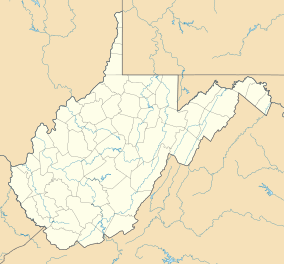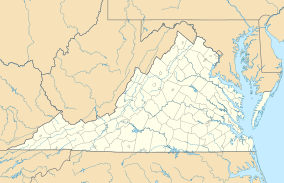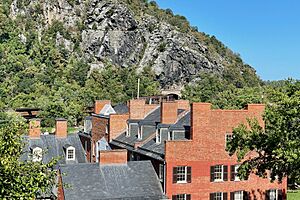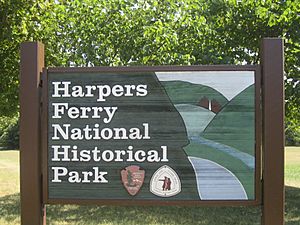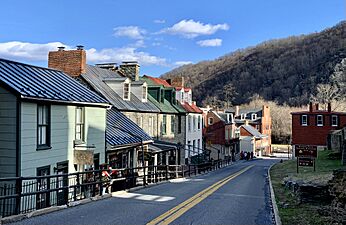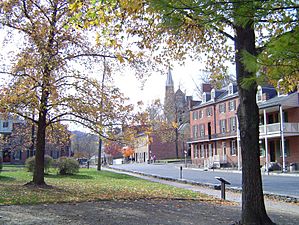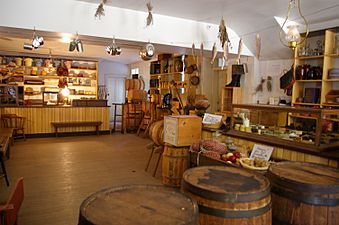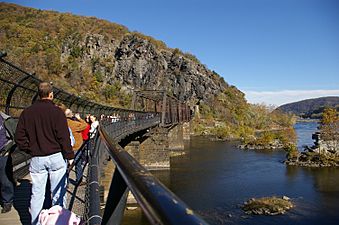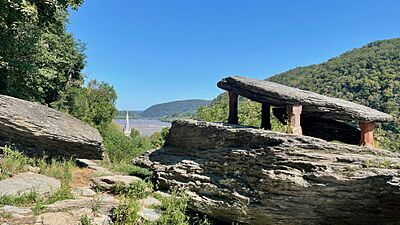Harpers Ferry National Historical Park facts for kids
Quick facts for kids Harpers Ferry National Historical Park |
|
|---|---|
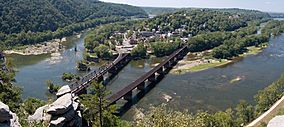
|
|
| Location | Maryland, Virginia, and West Virginia |
| Area | 3,660.73 acres (14.8144 km2) |
| Established | June 30, 1944 |
| Visitors | 407,008 (in 2022) |
| Governing body | National Park Service |
| Website | Harpers Ferry National Historical Park |
|
Harpers Ferry National Historical Park
|
|
| Location | Confluence of the Potomac and Shenandoah rivers Harpers Ferry, West Virginia |
| NRHP reference No. | 66000041 (original) 16000238 (increase) |
| Significant dates | |
| Added to NRHP | October 15, 1966 |
| Boundary increase | May 10, 2016 |
Harpers Ferry National Historical Park is a special place where two big rivers meet. It's located where the Potomac River and Shenandoah River join together. This park is in and around Harpers Ferry, West Virginia.
The park protects the old town center of Harpers Ferry. This area was important for factories in the 1800s. It was also where John Brown tried to start a rebellion to end slavery. His plan didn't work, but it was a very famous event. The most visited historical spot in West Virginia, John Brown's Fort, is here.
The park covers land in three states: West Virginia, Maryland, and Virginia. The National Park Service takes care of it. It started as a National Monument in 1944. Then, in 1963, it became a National Historical Park. The park is almost 4,000 acres big. Thomas Jefferson once said the view of the Potomac River cutting through the mountains here was "one of the most stupendous scenes in Nature." The park is full of history and fun outdoor activities. It's also close to Washington, D.C.. Because of its history and beauty, it was added to the National Register of Historic Places in 1966.
Contents
Exploring Harpers Ferry's Early Days
People have lived in this area for at least 8,000 years. The Tuscarora people were some of the last Native Americans here. They left in the early 1700s.
A European immigrant named Robert Harper got land here in 1751. West Virginia was part of Virginia back then. The town was first called Shenandoah Falls at Mr. Harper's Ferry. This was because Robert Harper ran a ferry business across the river.
Today, Robert Harper's original house is the oldest building in the lower part of the park. George Washington visited in 1785. He was looking for a way to ship goods west by water. Later, Washington started building a federal factory called the Harpers Ferry Armory here. It used the rivers' power to make things.
Making Weapons and Tools
Meriwether Lewis bought most of the weapons for the Lewis and Clark Expedition from the armory. Blacksmiths there even built a special iron boat frame for the trip.
From 1820 to 1840, a man named John H. Hall improved how things were made. He used special molds to make parts that could be swapped easily. This was a big step for modern manufacturing. It meant that gun parts could be standardized.
Later, James H. Burton invented a better bullet. The U.S. Army started using it in 1855. The armory employed up to 400 workers. It made over half a million guns between 1801 and 1860.
John Brown's Raid and the Civil War
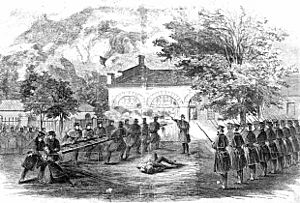
In 1859, John Brown, who wanted to end slavery, led an armed group. They took over the armory. Brown hoped to give weapons to enslaved people. He wanted them to fight for their freedom.
A group of U.S. Marines captured Brown at the armory. Their leader was Colonel Robert E. Lee. Brown was later hanged. He predicted that a civil war was coming. Less than two years later, his prediction came true. The firehouse where Brown fought the Marines is still standing. It's now called John Brown's Fort.
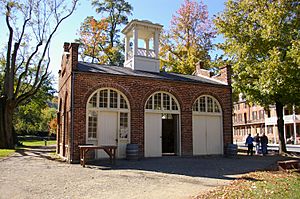
The American Civil War (1861–1865) made Harpers Ferry a very important place. It was right on the border between the Union (North) and Confederate (South) armies. Both sides wanted control of the town. The South especially wanted its factories.
The town changed hands eight times during the war. Union soldiers left the town when Virginia joined the Confederacy. They burned the armory and took 15,000 rifles. A week later, Colonel Thomas J. Jackson, known as "Stonewall," took the area for the Confederates. He sent most of the factory tools south.
Jackson built defenses for two months. But he was ordered to leave and help in another battle. Union troops then came back and started rebuilding the armory.
In September 1862, Stonewall Jackson returned. He was now a major general. Robert E. Lee ordered him to retake the arsenal. Jackson's attack led to 12,500 Union soldiers surrendering. This was the largest number of Union prisoners taken at one time during the war. The town changed hands several more times after that.
Storer College: A Place for Learning
Storer College was built in Harpers Ferry. It was one of the first integrated schools in the U.S. This means students of all races could attend together.
Frederick Douglass, a famous speaker and writer, was on the college's board. In 1881, he gave a memorable speech there about John Brown.
Later, Jim Crow Laws created legal segregation. Because of this, other African American leaders met at the school. Dr. W. E. B. Du Bois held the second Niagara Movement conference there in 1906. They discussed how to fight discrimination peacefully.
Storer College closed in 1955 after school segregation ended. What's left of the campus is now part of Harpers Ferry National Historical Park.
Harpers Ferry Park Today
Today, many museums are in the old 19th-century buildings of Harpers Ferry's Lower Town. Almost half a million people visit the park every year.
North of the park, across the Potomac River, is the Chesapeake and Ohio Canal National Historical Park. This canal was a busy waterway from 1828 to 1924. It helped move goods before railroads were common.
You can walk from Harpers Ferry to the canal towpath. A footbridge next to the railroad bridge crosses the Potomac. You can also drive to access points nearby.
Besides history, the park offers many outdoor activities. You can go fishing, boating, and whitewater rafting. There are also great places for hiking. The famous Appalachian Trail even goes right through the park!
The park is next to the Harpers Ferry Historic District. It's also near two other historic places: St. Peter's Roman Catholic Church and the B & O Railroad Potomac River Crossing.
In 2016, Harpers Ferry National Historical Park was featured on a special quarter. The quarter shows John Brown's Fort. It also has the year (2016), Harpers Ferry, and West Virginia. This was the 33rd park quarter in the America the Beautiful series.
The American Battlefield Trust has helped protect 542 acres of the battlefield. Most of this land has been added to the park. The entire park was listed on the National Register of Historic Places in 1966. Its special designation was expanded in 2016.
Lower Town: Historic Sites to Explore
The interesting spots in Lower Town are where the Shenandoah and Potomac rivers meet. They are along Shenandoah Street, Potomac Street, and High Street.
- Information Center
- Restoration Museum
- Frankel's Clothing Store
- Industry Museum
- Bookshop
- Blacksmith Shop
- Hamilton Street
- A Place in Time Museum
- Provost Marshal Office
- Stipes’ Boarding House
- Dry Goods Store
- Arsenal Square
- John Brown's Fort
- The Point
- John Brown Museum
- Wetlands Museum
- Storer College/Niagara Movement Museum
- A. Burton Clocks and Jewelry Exhibit
- 1862 Battle of Harpers Ferry Museum
- Confectionery Exhibit
- Civil War Museum
- Black Voices Museum
- White Hall Tavern
- Meriwether Lewis Exhibit
- Harper House
- Jefferson Rock
- Harper Cemetery
Virginius Island: A Lost Industrial Hub
Virginius Island was once a busy place. Before the Civil War, it had many factories powered by water. It was an important part of Harpers Ferry's economy. The Harpers Ferry train station was on Virginius Island. Train tracks still run through it today.
This island was home to many working-class families. But after the Civil War, its industries declined. Big floods eventually destroyed all the factories and homes. After a flood in 1936, no buildings were left. No one lived there anymore.
The National Park Service has studied Virginius Island's history. Many old ruins have been made safe to see. There are also footbridges and paths. You can visit it on a walking tour.
Images for kids
-
View from Jefferson Rock
See also


